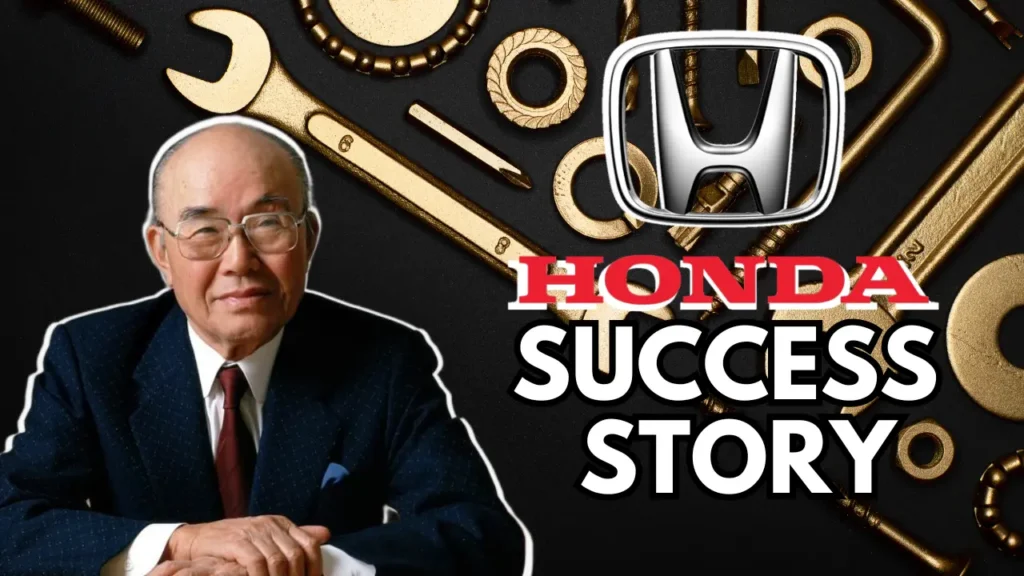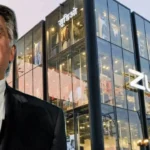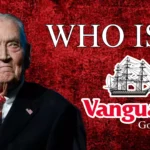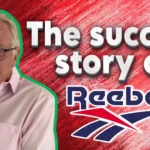Have you ever wondered how a poor boy from a small town in Japan who couldn’t even afford a bicycle created one of the world’s most iconic and successful automotive companies? The story of Soichiro Honda is a testament to the power of perseverance, innovation, and the pursuit of dreams.

Table of Contents
The Rise of Honda: From Poverty to Global Dominance
The Honda company earns nearly ₹ two crore every minute. Today, it manufactures bikes, cars, private jets, and even robots. But surprisingly, all this began with a poor boy who didn’t even have a bicycle in childhood.
Early Life and Struggles
The story begins in 1906. Soichiro Honda was born in a small town in Japan. His father was a blacksmith, and his mother worked as a seamstress. Their financial condition was terrible. It was so bad that they couldn’t even provide primary medical care to Soichiro’s five brothers and sisters, who tragically passed away in his childhood.
Discovering a Passion for Machines
One way to escape this situation was to study and get a job. Unfortunately, Soichiro was also very weak in their studies. However, there was still one hope left: machines. As a child, Soichiro used to go to a rice mill with his grandfather. The mill used a petrol-powered motor, which was rare then. The sound of the engine, the smoke coming out, and the smell of petrol fascinated him. Seeing this motor, he developed a passion for motors and machines.
A Life-Changing Encounter
At 11, something happened to Soichiro that gave his passion a life-changing direction. For the first time in his life, he saw a car. Soichiro was utterly mesmerized by it. When he saw the car, he started chasing it without a second thought. When the vehicle stopped at a distance, a small amount of petrol leaked under it. He bowed, smelled the petrol, and put it on his hands. At that moment, he decided to make his car one day.
Pursuing a Dream at Art Shokai
In 1922, Soichiro saw an ad in a magazine for a garage in Tokyo called Art Shokai, which was looking for workers. In those days, repairing cars in a garage was a dream job for Soichiro. He applied without delay and was lucky enough to get hired. He quit his studies and, at 14 years old, started heading towards Tokyo in search of his destiny.
Overcoming Challenges and Learning the Trade
Soichiro was pleased. He would finally work on something he had been passionate about for years. But the reality was different. From the very beginning, the owner of Art Shokai assigned Soichiro the task of cleaning and babysitting. Months passed, but he was not even allowed to touch the cars. He was losing hope and often thought of leaving the job and returning home. However, he stayed because he didn’t dare to face his parents after this failure.
A Stroke of Luck: The Great Kanto Earthquake
In 1923, a major earthquake struck Japan, the Great Kanto Earthquake. Entire Japan saw massive destruction. But surprisingly, this earthquake proved to be lucky for Soichiro. After the earthquake, most of the mechanics of Art Shokai returned to their villages to repair their homes. Now, the garage was only left with Soichiro and one more employee. Finally, the owner had to hire Soichiro to fix the car. He was now learning to fix cars and also got a chance to drive motorcycles and vehicles for testing. Everyone was surprised to see Soichiro’s work. He soon became the best mechanic there and kept getting promoted regularly.
Discovering a Passion for Motorsports
Meanwhile, the popularity of motorsports was increasing in Japan. So, the owner of Art Shokai asked Soichiro to assemble a racing car. Soichiro took the second-hand engine of the American Curtiss biplane and assembled a racing car named Curtiss using the body of an American vehicle named Mitchell. In the 1924 Japanese Motor Car Championship, this car participated and won the first position. In this race, Soichiro played the role of an accompanying engineer. This was a unique experience for Soichiro, and motorsports became his new obsession. However, he had no idea that this obsession would prove life-threatening for him in the future.
A New Venture: Partnering with Art Shokai
In 1928, Art Shokai decided to open a branch in Soichiro’s town of Hamamatsu and put him in charge of the store on a partnership basis. Everyone hoped that Soichiro’s shop would succeed instantly, but the opposite happened. The shop failed miserably. Soichiro was only 21 years old, and no customer wanted to take responsibility for their car to such a young boy. Soichiro needed to find a solution to stop the garage from closing as soon as possible. He observed that other garages often failed to repair cars or called them impossible. In such cases, Soichiro guaranteed to fix them and always delivered on his promise. Because of this, he developed a strong reputation in the market.
Building a Successful Garage Business
In the next few years, his shop grew very fast. In 1931, when he turned 25 years old, he earned a profit of 1,000 yen monthly and had a team of 50 people. During this time, Honda started assembling race cars again and participating in racing tournaments. By 1936, they had won many races and were beginning to see their future career in motorsports. But then, a tragedy happened.
A Life-Changing Accident
Before moving ahead, I want to tell you something that can make you rich. All the successful entrepreneurs I have studied have one thing in common: they all knowingly or unknowingly make five sacrifices that make them rich. If you want to know about these five sacrifices, I recommend listening to “5 Sacrifices to Become Rich” Bytes. These and all other Bytes are available on Kuku FM in Hindi. Bytes are an excellent solution for people who don’t find time to read books.
By listening to Bytes, you can cover the critical learnings of an entire book in just 15 minutes. The Byte’s narration is also very smooth; you can listen anytime while taking a morning walk, eating food, or sleeping. These three Bytes from Kuku FM have added much value to my life in the last few months. That’s why I recommend you check out the Bytes. If you are not a subscriber of Kuku FM, you can use my discount code SHIVANSHU50 and claim 50% off for the first month. Instead of ₹99, you can access Kuku FM for only ₹49. I have put the link to Kuku FM in the description and pinned a comment.
The Turning Point: Piston Rings and Metallurgy
Now, let’s return to the story of Honda. In July 1936his car met with a significant accident while racing while racing. When Soichiro opened his eyes in the hospital, he was feeling acute pain in his whole body. His face was severely injured, his left shoulder was dislocated, and his wrist was fractured. Sadly, Honda had no option but to leave racing forever. It took him 18 months to recover, and during this time, he decided to start manufacturing automobile parts. He would now manufacture piston rings, an essential component in cars in high demand then.
He gave the responsibility of the garage to his employees and, in 1937, established a company named Tokai Seiki. He hired 50 new employees and bought a lot of expensive machines. He had no experience making piston rings, so his family and friends warned him against this business. But Soichiro disagreed. He believed he could make it if he saw something only once. He started working with his workers day and night in the factory, but many months passed, and all his savings started to run out. Ultimately, he had to sell his wife’s jewelry to keep the factory running. Even after all this, he failed to make a proper piston ring.
Overcoming Challenges and Learning Metallurgy
Finally, Soichiro realized he needed more knowledge to make a proper piston ring. That’s why, at 31, he got admitted to Hamamatsu High School as an exceptional student to study metallurgy. He applied what he had learned in the factory, and finally, in November 1937, he made an acceptable piston ring. In the next two years, he not only successfully supplied piston rings to Toyota and other companies and started making parts and machinery for the Navy. By the 1940s, he had set up a massive plant, and his business increased.
The Impact of World War II
But then, a significant twist in the story occurred. It was the time of World War II, and Japan and America were fighting each other in a war. One day during the war, American fighter jets bombed from the sky and badly damaged Soichiro’s plant. He was recovering from this incident when 1945 a significant earthquake occurred in the Hamamatsu area, destroying his plant. After the war, his years of hard work and his country were both ruined. He had come back to zero. Soichiro sold his company’s remaining assets for ¥4.5 lakh and took a break from work.
The Birth of Honda Motor Company: Motorizing Bicycles
During this time, he got a Japanese army generator that the army used to run its wireless radios. After examining the engine, Soichiro devised an idea that laid the foundation of today’s Honda company. After the war, there was an acute shortage of fuel, which made it very expensive. That’s why most people have to travel everywhere by bicycle. Soichiro’s idea was to motorize these bicycles.
The Honda Technical Research Institute
In 1946, he started the Honda Technical Research Institute. Using his skills, he modified the military engine and fitted it into bicycles, creating an affordable motorcycle that became an instant success. However, there were two problems: first, he had only 500 military engines left, and the demand was very high; second, even the military engines ran on petrol, which was costly.
Innovating with Alternative Fuels
To solve these problems, Soichiro designed his engine and started making motorcycles using it. The unique thing about these motorcycles was that they didn’t need 100% petrol to run them. They could also run on a fuel made by mixing the resin made from the root of the pine tree with gasoline. This was the reason why Soichiro’s makeshift motorcycle sold like hotcakes.
The Dream Motorcycle: A Market Failure
After this success, Soichiro dreamed of making a proper motorcycle. To achieve this, he established the Honda Motor Company. A year later, in 1949, he made his first complete motorcycle, “Dream.” Unfortunately, this motorcycle failed in the market. The Dream motorcycle had excellent speed and style but was also heavy and expensive, making it unsuitable for ordinary Japanese men.
The Super Cub: A Revolutionary Two-Wheeler
After this failure, Soichiro made a perfect motorcycle for the middle class. The biggest problem was that engines that generated more power were much more significant and heavier, making the entire bike heavy. In 1952, Soichiro designed an engine called Cub, which was very small in size but very powerful. This innovation was a significant achievement for that era, earning him Japan’s Blue Ribbon award.
The engine was made, and it was time to make a motorcycle. Soichiro traveled worldwide, met many experts, and deeply understood motorcycle design. Finally, in 1958, he launched his revolutionary two-wheeler, the Super Cub. The Super Cub was an affordable and highly efficient motorcycle. Its most prominent feature was that anyone could drive it. As soon as it was launched, it almost instantly killed the competition in Japan. By the early 1960s, Honda had become the number one in the Japanese market, exporting millions of motorcycles to nearby countries yearly.
Conquering the American Market
However, the biggest market in the world was still to be captured: America. At that time, motorcycles had a terrible reputation in America, and people there believed that motorcycles were only used by criminals and biker gangs. To change this image, Honda used prestigious and popular magazines like Time, Life, and Look to advertise their motorcycles. But they cleverly didn’t use the word “motorcycle” in any ad.
Honda wanted decent people in America to accept their motorcycles, so they strategically selected the tagline of their ads: “You Meet the Nicest People on a Honda.” They showed familiar people like homemakers, working professionals, and students driving a Honda. This marketing strategy was so successful that by 1968, Honda sold 1 million motorcycles in America. By 1973, it had captured 43% of the American market share.
Expanding into Cars: The Honda Civic
Honda was on a roll, launching new and improved models individually. In the 1960s, they had become the most extensive motorcycle brand in the world. But Soichiro’s childhood dream was still incomplete: to make his cars. In the 1960s, companies like Toyota, Nissan, and Suzuki were already ruling the Japanese car market, and the competition was stiff. That’s why everyone advised Soichiro against entering car manufacturing. But Soichiro had already made a decision. By investing massive time and money, he launched his first four-wheeler in 1963, a pickup truck called T360. Unfortunately, this truck was a commercial failure.
Honda’s start in the car market was not good, but he kept going. He succeeded in the motorcycle market by making motorcycles for the commoner. Similarly, in 1967, he launched the Honda N360, a spacious and high-mileage car for joint Japanese families. Its USP was its price, which was around 25% cheaper than its competitors. As soon as it was launched, it disrupted the Japanese market.
Honda had succeeded in Japan but still needed to make a global impact with its four-wheelers. In the 1970s, Honda spotted a huge opportunity. The world was reeling under an oil crisis, making fuel expensive. At the same time, the US government was very concerned about the pollution caused by automobiles. The Clean Air Act imposed strict regulations on automobile companies, requiring them to modify their engines to reduce pollution.
All the car companies hired lawyers and filed cases against the US Government. Instead of hiring lawyers, Honda hired better engineers and started improving its engines. In the next few years, Honda launched the Compound Vortex Controlled Combustion Engine (CVCC engine), a breakthrough in the automobile industry. This engine was not only phenomenal in terms of pollution standards but was also fuel-efficient. No other company’s engine even came close to it.
In 1975, Honda launched its Honda Civic with the CVCC engine. This car fully satisfied the requirements of both customers and the government and shook the American car market. The Honda Civic became one of the most popular cars in the world, and its new models are still sold today.
The Rolls-Royce: Success, History, Case Study
Audi Success Story: Case Study of Audi and Future of Luxury Mobility
Mercedes-Benz: World’s First Car Success Story
Ford Sucess Story: The Incredible Rise of Henry Ford
A Legacy of Innovation and Success
After this success, there was no looking back for Honda. They launched models like the Honda Accord and Honda City, successfully targeting upscale customer segments. Finally, Soichiro Honda made cars that fascinated the entire world, fulfilling the big dream of a boy from a small city in Japan.
Soichiro Honda once said, “Success is 99% failure.” We are all scared of failure, but Soichiro Honda’s life story proves that failures are crucial to everyone’s journey. Every failure is an opportunity to learn, improve, and ultimately succeed.
Join me as we explore the fascinating journey of Soichiro Honda, a man who turned adversity into opportunity and built an empire from scratch.
In this blog post, we will delve into:
- Soichiro Honda’s humble beginnings and early life
- His passion for machines and his determination to succeed
- The challenges he faced and overcame throughout his career
- The innovations and breakthroughs that made Honda a global leader
- The lasting legacy of Soichiro Honda and his impact on the automotive industry
- But before we begin, I’d love to hear from you.
What do you know about Soichiro Honda or the Honda company? Are you a fan of Honda vehicles? What questions do you have about his life and career? Please share your thoughts in the comments below, and let’s embark on this inspiring journey together.










